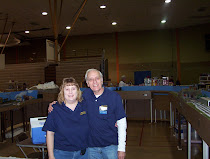An elderly Henry Fuller "Twelve Foot" Davis (seated)
Th
 e grave of "Twelve Foot" Davis on a
e grave of "Twelve Foot" Davis on ahillside overlooking the confluence of the Peace and Smokey Rivers. Peace River District, Alberta, Canada.
http://imagescn.technomuses.ca/people/index_choice.cfm?id=28&photoid=-1720225521
Vermont born Henry Fuller Davis got his nickname in Canada's Cariboo Gold Rush of 1861. Davis was a veteran Forty-Niner from the California Gold Rush and when the race for gold moved north to Canada, H.F. Davis went with it. Nonetheless, by the time Davis arrived in the Cariboo region, all the best claims had been staked out by other miners.
Davis was a shrewd man, and with a bit of sleuthing he discovered that the original discovery claim on Williams Creek and one adjacent claim were performing particularly well. Late one night, Davis stepped off the borders of the two claims and found that both were slightly over their legal limits. Davis promptly filed a claim for the resulting fraction, a 12' strip of unaccounted-for land between the two claims. Davis recovered $12,000-15,000 US in gold, and then sold the fraction for a further gain.
Davis, now permanently stuck with the moniker 'Twelve Foot' headed out to the Peace River country in 1865. He established a series of trading posts along the river, using his gold money to finance them. He set up his main post directly opposite that of the mighty Hudson's Bay Company post. Taking advantage of the lethargy that dogs large corporate enterprise to this day, Davis varied the prices he paid trappers for furs so that they were always just a bit better than the Hudson's Bay Company prices. HBC had to wait for changes to be approved by the head office in Winnipeg, and this gave him plenty of lead time. HBC tried many times to quell the success of this Yankee Trader but never managed to do so.
Davis succeeded at the fur trade, and was also famous for his stamina on the trail, often outworking all others in hauling twice the 100-pound loads assigned to his men up the trail. But his lasting fame in the region came from his open-door policy. His cabin was always open to travellers looking for a meal or a place to sleep. Even when Twelve Foot was out on the trail, his cabin was always left open for shelter and rest.
Davis died at Lesser Slave Lake in 1900, and his remains were later reburied in sight of the Peace River. His grave marker reads:
Twelve Foot DavisIn the town of Peace River today, a monument to Twelve Foot Davis stands near the Heart River Bridge on Grouard Hill, and is a favorite "Big Thing" for tourists to snap a photo with.
Pathfinder, Pioneer, Miner and Trader
He was Every Man's Friend and Never
Locked his cabin Door


1 comments:
What does this have to do with Model Trains?
Post a Comment